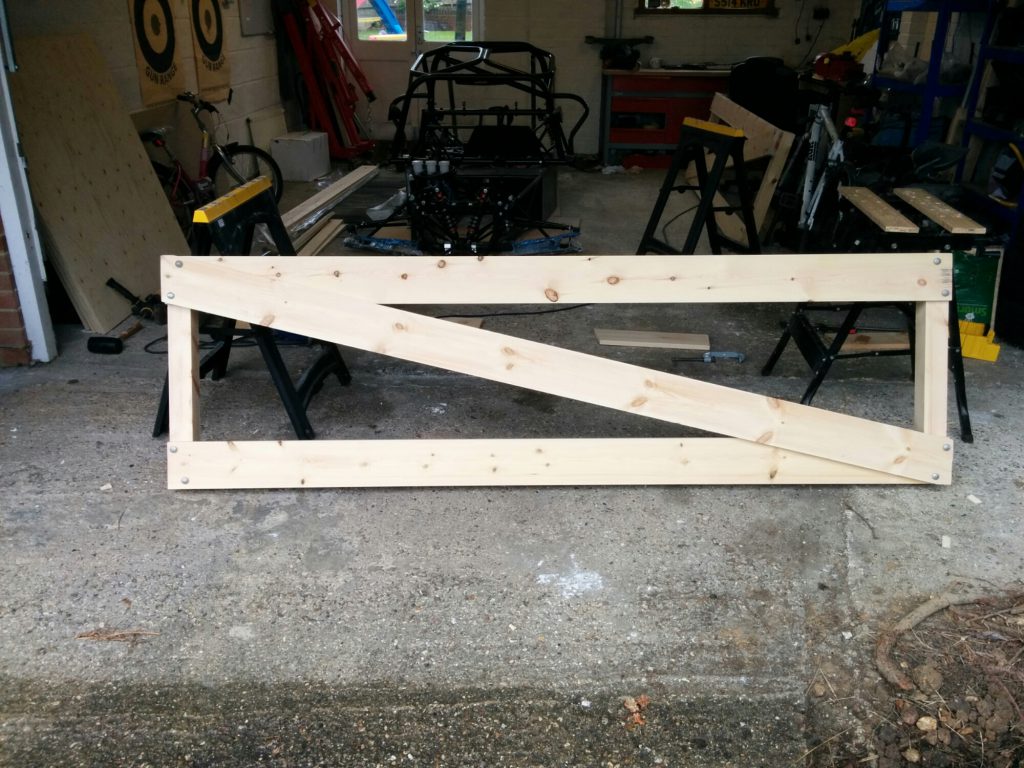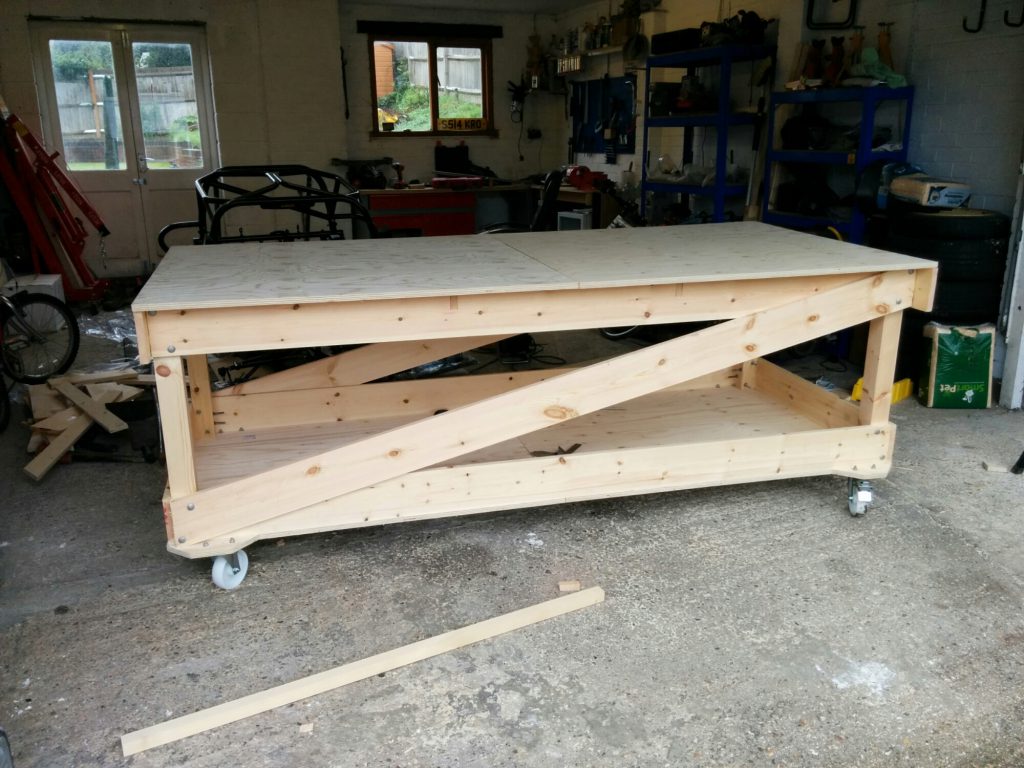I imagine this is the case with any family man who buys a kit car… I’ve had chance to do practically nothing with it over the past couple of months. It’s simply sat on the floor gathering dust while I try to stop the kids dropping their bikes on it, or my 18 month old walking boy over to “help” with a screwdriver.
Instead I have mostly being:
- Removing an old fountain & patio
- Removing a concrete shed base
- Removing a flower bed
- Putting in a barked area for a trampoline
- Turfing the gaps
- Sorting the spare bedroom for plastering
- Getting rid of a 30-40ft tree (my nemesis)
We’ve also been abroad for a week. I enjoy doing all of the above so it’s not all bad news. I’ve just been getting that creeping feeling of guilt around the SR2.
This weekend has been a typical drizzly bank holiday so I got myself out to buy parts for a build stand. Here is a picture of the finished stand. It was around £150 of parts and a day & a half’s work (I’ll tot up more accurately when I check the bank statement).
As with my dodgy petrol siphoning, I have a disclaimer before I go through how to build this. I’ve never made a build stand before so chances are I’ve done multiple things wrong. I don’t know if it will take the weight as the car gets closer to completion and I’ve not fully thought through how I will get it down again. Soon as I tried putting the chassis up there I noticed my first mistake. The castors I bought don’t give enough clearance to get the engine winch under the base by maybe 40mm!! It sure is pretty though! 🙂 That being said, here is a parts list to build the same stand:
- 2 x 69mm x 69mm x 2.4m from B&Q
- 5 x 20mm x 140mm x 2.5m from Wickes
- 2 x 20mm x 140mm x 3.4m from Wickes
- 4 x 125mm swivel castor with brake from toolstation
- 48 x m8 x 130mm coach bolt from B&Q
- 2 x 18mm x 2.44m x 1.14m structural plywood from Wickes (I trimmed from 1.22m wide to get it in the car)
- 50 x 3.5mm x 40mm screw
Start off by building the side panels. I did this by using a g-clamp to hold the upright and cross member together then drill a couple of holes with an 8mm auger. Make sure to position these to each side of the upright so that it won’t pivot.
Once the two verticals and horizontals are in place (being careful that everything is square before drilling each hole) it’s time to do the diagonal cross member. I did this by tapping the coach bolts in from the wrong side and flush with the surface of the wood. Then clamp it up, take the bolts out and drill from the “wrong” side. I.e. through the existing holes to make sure it lines up.
Do both ends, trim any excess wood off with a jigsaw and you have one of these
Now make a second one 🙂 you can now clamp the width cross members in place to start making a box. I went for 1.14m wide on the top (7cm sticking out each side) and 1.0m wide at the bottom. This will hopefully give better strength where the weight is while supporting the full width of the worktop. You should now have something that looks like this.
Now turn it over to work on the base and fitting the castors. I’ve trimmed 7cm off each side to get it down to 1m apart from a section upon which to mount the castor. I moved these along the length of the table a bit in order to get away from the bottom of the upright. I aimed for two brackets either side of the cross member and as close to the upright as possible
And here is a closer version with marking for the castor bolt holes.
I secured the base around 8″ apart round the cross members with additional screws at the corners and into the base of the uprights.
Then drill with an 8mm auger and fit the castors after cutting down those long ugly coach bolts
Now flip her over and onto the home straight. At this point my wife came outside to see if I’d be finished soon. I came outside at 08:00 “for 20 minutes” and it was now 15:20!
Time to add in a couple of additional braces to support the plywood worktop and provide and provide a little more rigidity. I did this using a carefully cut 60mm tall x 21mm wide slot into the longer cross member. If I were to do it again I’d reduce this to around 40mm tall x 21mm wide in order to retain more strength.
Go through the same process is screwing in every 8″ et voilà! Completed build stand!! 🙂
I then took a few attempts to lift the chassis with out adding any dings or scratches.
But I now have a chassis on a build stand that I can move freely around the garage. I’m a happy man!
I just need to clean it up and put a dust sheet over it now until I can get on to assembling it. Prepping and mounting the diff I reckon.
If you have any feedback or suggestions please drop them in the comments box.










Hi there
Nice stand , what about just mounting the castors on the side instead of the bottom ? should get you 40mm easy ?
regards Paul
Hi,
I’m having a dense morning here :-)…. I’m not sure what you mean by mounting castors on the side?
Sideways on? On the side of the legs? I was trying to get all of the weight from the legs and cross members directly on top of each castor. The best solution I can think of so far is to “pad out” each castor with some sheets if 18mm ply and longer bolts
Dave
Dave
Sorry I think I miss read your post and assumed the trolley was 40mm to high for the crane to clear the chassis when the engine was suspended from it.
Now I think you are saying it is 40mm to low for the feet of the crane to get under the trolley and so get close to the chassis whilst carrying the engine ?
In that case I was talking rot , sorry.
Paul